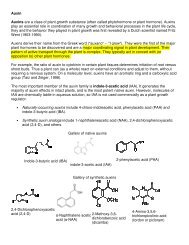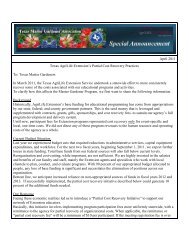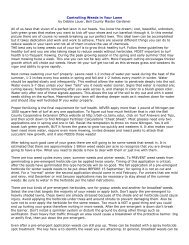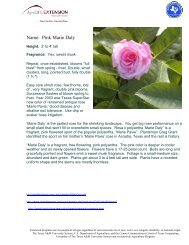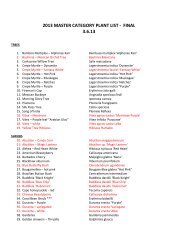Graywater - Texas Master Gardeners Association
Graywater - Texas Master Gardeners Association
Graywater - Texas Master Gardeners Association
You also want an ePaper? Increase the reach of your titles
YUMPU automatically turns print PDFs into web optimized ePapers that Google loves.
guidance for graywater use. Regulatory<br />
guidance for graywater flows is presented<br />
in Title 30 of the <strong>Texas</strong> Administrative<br />
Code, Chapter 285. In <strong>Texas</strong>,<br />
local authorities generally do not issue<br />
permits for systems from single family<br />
residences with daily graywater flow of<br />
less than 400 gallons.<br />
Residential<br />
wastewater<br />
sources<br />
Residential wastewater can be divided<br />
into blackwater and graywater,<br />
depending on its source. The <strong>Texas</strong><br />
Water Code (Code) defines graywater<br />
as water discharged from<br />
showers<br />
bathtubs<br />
handwashing lavatories<br />
sinks (not used for disposal of<br />
hazardous or toxic materials)<br />
sinks (not used for food preparation<br />
or disposal)<br />
clothes-washing machines<br />
The Code’s definition excludes<br />
water discharged after washing<br />
materials soiled with human excreta<br />
(e.g., diapers) and wastewater that has<br />
contacted toilet waste.<br />
Blackwater contains relatively<br />
higher concentrations of nitrogen,<br />
organic matter and human pathogens<br />
than does graywater. Blackwater<br />
includes flush water from toilets and<br />
urinals and wastewater from food<br />
preparation sinks. Fig. 1 illustrates average<br />
daily percentages of graywater<br />
and blackwater from various sources.<br />
<strong>Graywater</strong><br />
separation<br />
To be reused, graywater first<br />
must be separated from blackwater,<br />
upstream of any treatment systems.<br />
Such separation must be done both<br />
Figure 1. Wastewater from blackwater<br />
and graywater sources, by<br />
percentage.<br />
for households equipped with onsite<br />
wastewater treatment systems and for<br />
those plumbed into municipal sewer<br />
systems.<br />
Diversion splits blackwater from<br />
graywater using two separate pipe<br />
collection systems inside a house,<br />
running to appropriate fixtures (Fig.<br />
2). Toilet water can be treated with<br />
technologies such as non-discharging<br />
toilets (incinerating and composting)<br />
or can be directed to a separate onsite<br />
wastewater treatment system. Once<br />
separated, graywater can be diverted<br />
for reuse, such as for landscape irrigation,<br />
or it can be directed first to an<br />
onsite wastewater treatment system for<br />
further treatment. Fig. 3 illustrates the<br />
four primary components of an onsite<br />
wastewater treatment system. <strong>Graywater</strong><br />
diverted by a separation system<br />
would be introduced upstream of its<br />
collection and storage components<br />
of the onsite wastewater treatment<br />
system.<br />
Figure 2. House diagram of separate blackwater and graywater plumbing<br />
systems.








